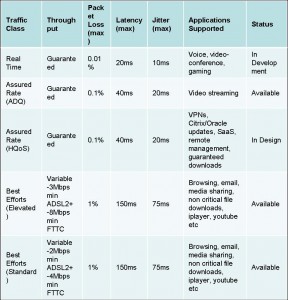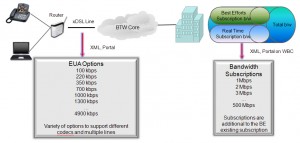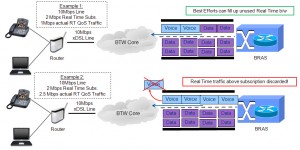Coming down the broadband pipe this year to a telephone exchange near you is BT’s Real Time QoS product. QoS might not be of interest to your everyday surfer. It does however have the potential to revolutionise the User Experience when using the internet with better control of voice and gaming quality.
What is QoS?
Quality of Service (QoS) in a network is usually the term used to describe the process whereby certain types of network traffic are prioritised above others. QoS is typically required in a network where time-critical applications are being supported. In most cases this means Voice over IP or video but can be applied to financial transactions and gaming (to improve the experience). There isn’t a definitive list. By and large if you design a network with enough capacity to accommodate your bandwidth needs you don’t have to implement QoS.
In practical terms, where ADSL is concerned, this usually means providing a dedicated broadband connection for sensitive applications such as VoIP so that, in this case, voice traffic doesn’t have to compete with email and other traffic.
Even if a shared connection is used typically a router can control the uplink QoS, at least so that sending emails doesn’t interfere with the voice.
Where there is no control over the quality is in the local exchange. Traditionally traffic at the DSLAM (or MSAN in 21CN parlance) is on a best efforts basis. There is rarely a problem for VoIP but quality is not guaranteed and this does to some extent take the shine off the new world network offering.
BT’s 21st Century Network has been designed to support QoS and it is expected that this service improvement will be productised and offered to customers this year.
Which services will offer QoS?
QoS will be available on all flavours of 21CN. These are currently, ADSL2+ (the “up to 24Mbps service”), Fibre To The Cabinet (“up to 40Mbps”) and Fibre To The Premises (“up to BT” as they haven’t yet announced it – basically “up to” the speed of light 🙂 )
QoS is really the icing on the cake from the networking perspective. It brings the 21CN network finally into the 21st Century. Although we don’t know how much it is going to cost yet I would expect there to be significant interest in the service from a variety of sources.
These include businesses wanting to use VoIP, Communications providers wanting to sell consumers low cost additional home telephone lines and people wanting to improve the experience when playing interactive online games. The days of my internet gaming son calling out to his friend “are you there” should soon be long gone.
The Types of traffic in BT’s 21CN Roadmap
The table below shows the types of traffic supported by the 21CN network together with its status in the roadmap.

For the non technical amongst us the lower the number for Packet Loss, latency and Jitter the better and certainly the numbers quoted above for Real Time are very acceptable. In fact none of the numbers cited in the charts for these parameters will typically cause problems for VoIP. The biggest difference is that throughput is guaranteed for some of the lines but not for others.
Essentially this product bridges the gap between Broadband and quality assured Ethernet and MPLS networks. Communications Providers such as Timico will be able to offer the same services over a variety of access mechanisms (ADSL, FTTC, EFM etc).

How Does it Work?
The BT network essentially supports a standard communications protocol called Diff Serv. Diff Serv allows network providers to “Tag” their traffic to tell the network what priority to give this traffic. In a multimedia VoIP network the highest priority will typically be given to the signalling packets. These are the messages that tell the voice packets where to go. Voice will then have second priority and video lowest. Priorities could be different in different networks depending on the type of service most important to particular users of the network.
How will I be able to order QoS – what will it actually look like?
There are two perspectives here – ISP and End User. There are two flavours of bandwidth that will need to be ordered by an ISP.
Firstly the End User Access options. This is how much QoS bandwidth does the end customer want on his line. This will largely be determined by how many voice or video channels they want to run over the connection. You want one voice channel? That will be the 100kbps option then sir.
In practice I doubt that ISPs will confuse their customers with the technicalities. They are more likely to sell services with user friendly terms – none proffered here – I’m not a marketeer (ok how about “broadband phoneline”?).
The second type of bandwidth that needs to be ordered is the backhaul bandwidth. This is the connection that brings traffic from the local exchange to the ISPs own core network and then on to the internet. Backhaul bandwidth is not generally something of concern to a specific user but they should understand that it is the major contributor to the cost of a broadband connection. The more people download the more it costs, which is why you see most ISPs moving to a usage based charging model.
This is what the bandwidth ordering model looks like diagrammatically:

How is Real Time QoS managed on a Line?
The management of the line capacity is done at the Broadband Remote Access Server (BRAS). Real Time has the absolute priority over all other line traffic up to the level of the line Real Time subscription. If all the Real Time subscription bandwidth is not being used it can be filled with Best Efforts traffic as required and until Real Time demand returns. This makes for the most efficient use of a pipe.

What else do I need to know about Real Time product options?
Real Time will be available in all types of WBC access (ADSL, ADSL2+, FTTC, FTTP) and will be ordered via the normal eCo plus portal.
An ISP will be expected to wait for a new installation to stabilise before ordering Real Time QoS as the final line speed will not be known before this time. Clearly there is no point in ordering 10Mbps of Real Time if the actual line speed is only 5Mbps.
Real Time is aimed to be bi-directional and will be monitored by BT. BT does recommend that at least 15% of the line capacity is allowed for Best Efforts traffic in both directions.
ISPs must ensure their CPE (customer premises equipment, ie router) priorities Real Time traffic first above other traffic types.
Conclusion
The Real Time QoS product is going to be a major step forward for BT and the UK communications industry and certainly brings us firmly, if belatedly, into the advanced 21st Century Networked world. QoS sets the scene for a new breed of real time services to be rolled out with confidence. For example QoS provides a solid platform for genuine High Definition voice services providing a level of customer experience that at last takes us away from the old Public Switched Telephony Network.
BT’s Real Time QoS will hit the streets later this year. Prior to launch all the specs in this post are of course subject to change but I think it does provide quite a good indication as to how it will work.

2 replies on “The BT Real Time Quality of Service Proposition”
Tref that’s an absolute classic “up to BT” – made my afternoon that 🙂
G
Interesting to see if they get away with this approach. Only BT Retail use ADQ for their Video on demand service.
So, 3to 4 queues, bottom best effort queue gets squezzed every busy period or will the planning rules guarantee the 1% packet loss and 150 Ms round trip time.
Might be better if they re-define best efforts with a .1% packet loss and provide controls to avoid peak hour overload.
I indicatice prices for this a year ago, and rural users will not be happy with the prices for Market 1 exchanges.